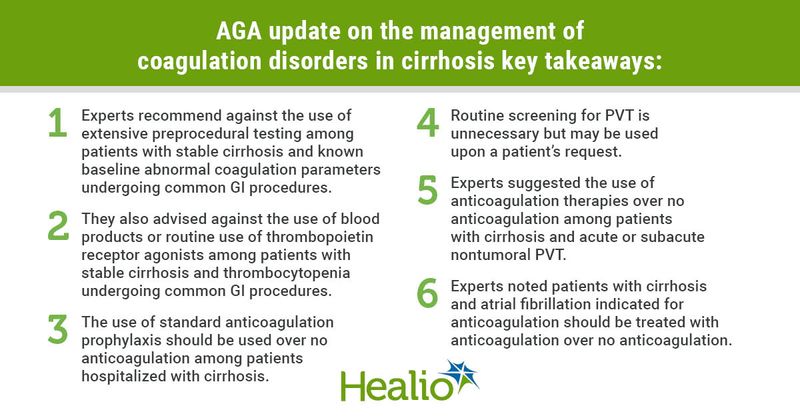AGA issues guidelines for coagulation disorder management
The AGA published clinical practice guidelines in Gastroenterology for the management of coagulation disorders among patients with cirrhosis.
“Cirrhosis is a disease state that is accompanied by significant alterations in laboratory parameters. ... Based on this measured thrombocytopenia and coagulopathy, it has traditionally been assumed that these results convey a high risk of bleeding and, therefore, significantly increased risk for patients undergoing invasive procedures,” Robert S. O’Shea, of the Digestive Disease and Surgery Institute at Cleveland Clinic, and colleagues wrote. “However, it has become clear that this understanding underestimates the balanced nature of alterations in hemostasis associated with end-stage liver disease and that neither thrombocytopenia nor elevated prothrombin time/international normalized ratio (PT/INR) necessarily predicts bleeding outcomes in most of these patients.”

Aimed to provide recommendations for clinically relevant questions related to homeostasis of bleeding as well as the prevention and treatment of thrombosis, experts performed a technical review supplemented by a systematic review and meta-analysis of available evidence. Clinical practice guidelines address proper testing strategies, screening for nontumoral portal vein thrombosis (PVT), anticoagulation and more.
Clinically relevant questions and expert recommendations follow.
What testing strategy for bleeding risk assessment is most beneficial for patients with cirrhosis?
Among patients with stable cirrhosis with known baseline abnormal coagulation parameters undergoing common gastrointestinal procedures, AGA experts recommend against the use of extensive preprocedural testing like repeat measurements of PT/INR or platelet count.
They made no recommendation regarding preprocedural viscoelastic testing (VET) to predict the risk for bleeding.
Does preprocedure prophylaxis to correct coagulation parameters reduce the risk for bleeding?
Among patients with stable cirrhosis as well as patients with stable cirrhosis and thrombocytopenia, experts advised against the use of blood products or the routine use of thrombopoietin receptor agonists (TPO-RAs) when undergoing common GI procedures such as paracentesis, thoracentesis, variceal banding, colonic polypectomy, ERCP and liver biopsy.
Is venous thromboembolism (VTE) prophylaxis with anticoagulation indicated in hospitalized patients with cirrhosis?
The use of standard anticoagulation prophylaxis should be used over no anticoagulation among patients hospitalized with cirrhosis. These patients must also meet the standard guidelines for VTE prophylaxis use.
Should patients with cirrhosis be screened for PVT?
Routine screening for PVT is unnecessary but may be used upon a patient’s request.
What anticoagulation therapies should be offered for the treatment of PVT?
Experts suggested the use of anticoagulation therapies over no anticoagulation among patients with cirrhosis and acute or subacute nontumoral PVT.
Should patients with atrial fibrillation and cirrhosis be treated with anticoagulation?
Experts noted patients with cirrhosis and atrial fibrillation indicated for anticoagulation should be treated with anticoagulation over no anticoagulation.
“Although the understanding of the delicate balance between procoagulant and anticoagulant factors in cirrhosis has advanced significantly, this knowledge has yet to translate directly into evidence-based recommendations for clinical care and multiple highly significant questions and knowledge gaps remain,” O’Shea and colleagues concluded. “Future research should focus on the best strategies to identify patients at risk for bleeding or thrombosis, to appropriately provide prophylaxis using blood product transfusion or TPO-RAs in patients at risk for clinically significant bleeding, to screen for and treat PVT and to prevent clinically significant thromboembolic events.”
